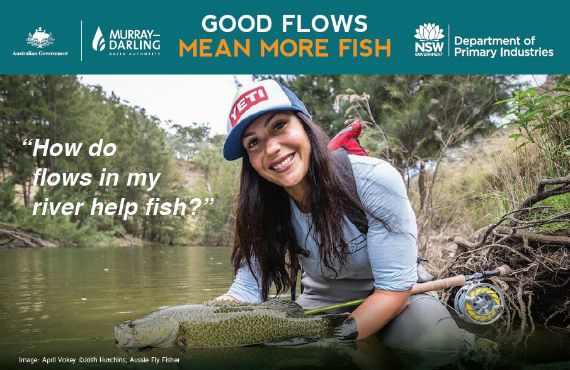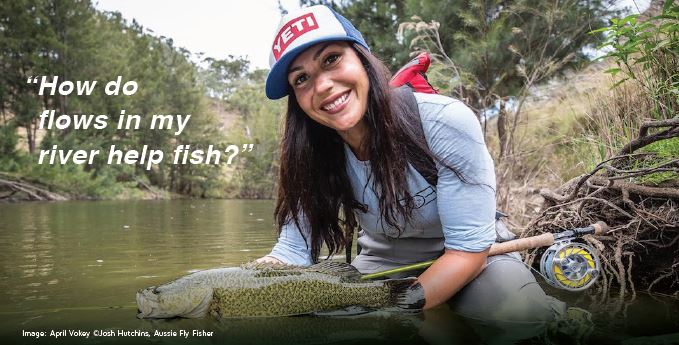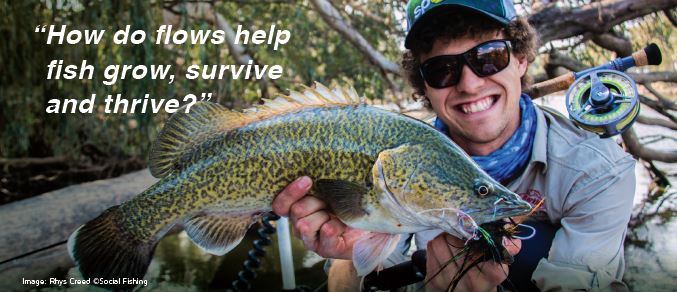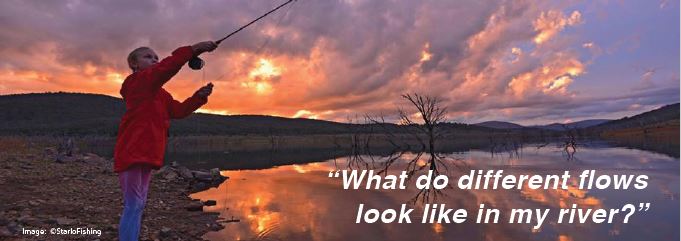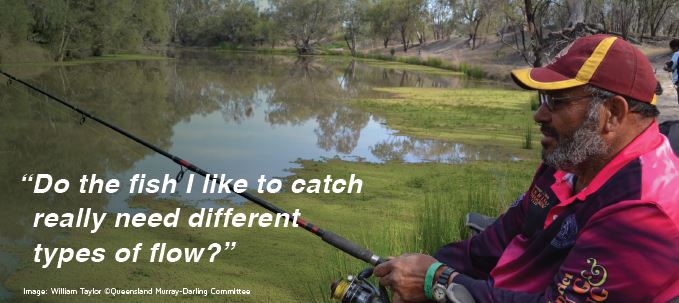
Fish and flows
Good Flows Mean More Fish
Find out how flows help native fish grow, survive and thrive, what NSW Department of Primary Industries is doing to boost awareness of fish and flows science and engagement, and how you can help.
Water and fish go together, but in recent years we have gained a better understanding of how fish numbers are linked to the way water flows throughout river systems.
There are 46 native fish species in the Murray–Darling Basin (MDB), and each one has evolved differently to the boom and bust nature of flow common in Australian rivers. This means they are reliant on the variety of different flows experienced within a river in order to breed and thrive.
Due to this dependence on flow variability, most native fish in the MDB are suffering from changes humans have made in the river system.
The protection and recovery of native fish stocks provides a range of environmental, social and economic benefits. Fish play a critical role in the river system by cycling nutrients, providing food for other parts of the food web like waterbirds, and sustaining a billion dollar a year recreational fishing industry. They are also important in the social well-being of indigenous and non-indigenous MDB communities.
What is DPI Fisheries doing to help fish and flows in the Murray-Darling Basin?
DPI Fisheries is helping to implement the Murray-Darling Basin Plan, a major Basin-wide investment, to achieve positive environmental outcomes in our rivers and waterways. Water for the Environment provides opportunities to assist fish communities in recovering from impacts associated with river regulation and human uses of water.
We use the best available science and knowledge regarding native fish requirements to guide water management and rehabilitation activities. We work with a range of other government organisations and communities to get the best outcomes possible through efficient use of environmental water and by undertaking parallel complementary actions (such as improving fish habitat through re-snagging, restoring instream vegetation, riverbank management, fish passage, screening pumps and diversions and controlling invasive species). Flow management and complementary actions working in parallel will support bringing native fish back to a healthy working Basin, and will increase the potential to achieve long term social and environmental outcomes through water management.
More detailed information on developing flows for fish for natural resource managers can be found in the following documents:
- Northern Basin (PDF, 3.99 MB)
- Southern Basin
- Southern Basin: Condensed Summary
- Murray River (PDF, 2135.85 KB)
Habitat Mapping
DPI Fisheries undertakes habitat mapping along waterways to identify and record key features that influence native fish numbers, diversity and condition. Features along riverbanks such as exotic weeds, native vegetation, fences and erosion have positive and negative influences on native fish. Similarly, aquatic habitat assets including refugia, riffles, Large Woody Habitat (snags) and in-channel benches all have an effect on native fish and river health.
DPI Fisheries maps all these riparian and aquatic assets using various types of technology and uses the information to guide management actions by identifying:
- What flows are needed to inundate key habitat features, providing measurable outcomes for supporting and increasing native fish
- Areas of waterway that are in better condition that need protection
- Areas of waterway that are in poorer condition and in need of rehabilitation
- Where fish can survive during low and no flow periods
- Where barriers to fish movement are.
This knowledge is important to make informed decisions about how we can provide the best outcomes for native fish and river health in the Murray-Darling Basin.
Recently, DPI Fisheries undertook detailed habitat mapping along 327 km of the Macintyre and Barwon Rivers from the Dumaresq River junction to Mungindi, to identify the location and condition of key habitat features and the flows needed to inundate them. An infographic detailing the results can be downloaded here.
Engaging with recreational anglers
There are an estimated 430,000 recreational fishers in the MDB, which currently contribute around $1.3 billion each year to the Australian economy. In a recent survey recreational anglers from across the MDB asked for better information on the way fish respond to changes in flow, and in turn what that could mean for fishing in their local rivers over both the short and long term.
NSW DPI Fisheries, in partnership with the Murray-Darling Basin Authority, worked with keen anglers from across the NSW Basin to develop five easy to read infographics (pictures which aim to present information quickly and clearly) which answer some common questions posed by fishers and lovers of our river systems:
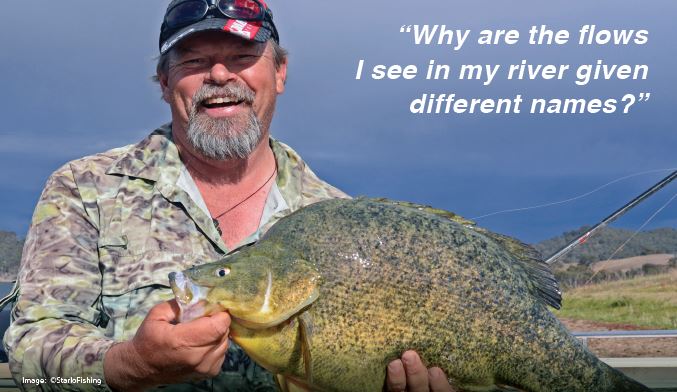
We encourage recreational fishers, natural resource managers and the broader community to print and use these infographics to help their friends and colleges better understand what our fish need in terms of flow. The infographics may be particularly useful at your local fishing stores or club event, schools, and other natural resource management events.
These infographics are based on best available science on fish and flows across the Murray-Darling Basin. More detailed information can be found in the following documents for the Northern Basin (PDF, 3.99 MB) and Murray River (PDF, 2135.85 KB) and the River Flows for Our Fish survey of recreational fishers by DPI Fisheries in late 2016 and early 2017.
NSW DPI Fisheries in partnership with the Murray-Darling Basin Authority has also developed a short video (YouTube) aimed at raising awareness among recreational fishers on the benefits and positive outcomes of environmental watering to native fish in the Murray Darling Basin from a recreational fishers’ point of view.
The video was largely filmed on location in Canberra as part of the Murray-Darling Basin Native Fish Forum in August 2017 and includes riverside interviews with three members of the Engaged Anglers Advisory Group (Phil Beesley, Albury NSW, Graeme May, Hillston NSW and Anne Michie, Tamworth NSW), along
with fish scientist Clayton Sharpe.
Video transcript (DOCX, 16.28 KB)
Report on values of native fish and recreational fishing in the Murray-Darling Basin – scoping study proposed for Macquarie-Castlereagh
The Murray-Darling Basin (MDB) has between 400,000 and 500,000 recreational fishers supporting around 10,000 jobs. Tourism has an economic value of around $7.5 billion for the Basin each year. The MDBA recently released a report showing that environmental outcomes like healthy native fish communities can make very important economic and social contributions.
MDB recreational fishers like to catch several iconic native fish species like Murray Cod and Golden Perch. Both these fish are known to respond to changes in flows. How flows are managed can have a big impact on the health and numbers of these important fish, and their local, regional and Basin-wide economic and social values.
We already know something about the economic and social values of recreational fishing at the scale of the MDB (PDF, 1.39 MB) and across NSW as a whole (PDF, 1464.37 KB).
Understanding valley-specific information on how recreational fishers value the fish they like to catch and broader social and community values around native fish would help us make informed decisions for Basin Plan implementation and water reform in NSW.
Recreational fishers expect the native fisheries of the Murray-Darling Basin to be robust and sustainable and are keen to be involved. They see the Basin Plan and associated water reform in NSW and elsewhere as providing great opportunities to enhance fish populations at a large scale, with employment opportunities and boosts to regional economies.
The Murray-Darling Basin Authority funded NSW DPI Fisheries to manage this scoping work as part of a broader project to improve recreational fisher understanding and awareness of environmental flow benefits for native fish. This final report (PDF, 1101.41 KB) provides a review of available economic valuation techniques, existing information on native fish and recreational angling in the MDB and recommends next steps for implementation in the Macquarie-Castlereagh valley.
How can you get involved or find out more?
Send us an email, we are happy to chat all things fish!
Accessibility
Some of the content in the communication products does not comply with WCAG 2.0 accessibility requirements. To obtain accessible versions of images and other information contact:
Rod Price
Fisheries Manager - MDB Habitat Rehabilitation
rodney.price@dpi.nsw.gov.au

